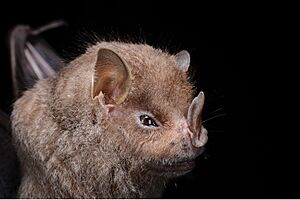Guadeloupe big-eyed bat facts for kids
Quick facts for kids Guadeloupe big-eyed bat |
|
|---|---|
 |
|
| Conservation status | |
| Scientific classification | |
| Genus: |
Chiroderma
|
| Species: |
improvisum
|
The Guadeloupe big-eyed bat (Chiroderma improvisum) is a special kind of bat. It belongs to a group of bats called Phyllostomidae. You can find this bat on the islands of Guadeloupe and Montserrat in the Caribbean Sea. Sadly, this bat is in danger. Its home is being lost, especially after Hurricane Hugo in 1989. That hurricane destroyed a lot of its population.
Contents
About Its Name and Discovery
Scientists first described the Guadeloupe big-eyed bat in 1976. The main bat they studied, called a holotype, was found in July 1974. It was discovered in a place called Baie-Mahault on Basse-Terre Island.
The bat's scientific name, improvisum, comes from a Latin word. It means "unforeseen" or "unexpected." The scientists who named it, Baker and Genoways, chose this name because they were surprised. They did not expect to find this type of bat on Guadeloupe. The closest known bats like it were far away in Trinidad and Tobago.
At first, scientists thought this bat might be closely related to the Brazilian big-eyed bat. They wondered if they were once part of one big group. But later, in 1994, scientists studied the bat's mitochondrial DNA. They found that the Guadeloupe big-eyed bat is actually most closely related to the hairy big-eyed bat. These two bats separated from each other about 2.1 million years ago.
What Does It Look Like?
This bat is the largest in its group, called Chiroderma. Its body is about 85 to 88 millimeters (3.3 to 3.5 inches) long. Its forearm, which is part of its wing, is about 57.5 millimeters (2.3 inches) long. The bat has a special nose-leaf that is about 5.9 millimeters (0.23 inches) long. Its back feet are 15 to 17 millimeters (0.59 to 0.67 inches) long. Its ears are about 21 to 21.5 millimeters (0.83 to 0.85 inches) long.
The fur of this bat feels like wool. The hairs on its back are about 10 millimeters (0.39 inches) long. Most of its fur is a light brownish-gray color. The bottom part of each hair is darker. The tips of the hairs are a rich, dark brown. Some of these bats have a clear white stripe down their backs. The fur on their bellies is grayish-brown. The tips of these hairs are white.
Life and Habits
The Guadeloupe big-eyed bat mostly eats fruit. This means it is a frugivore. Not much is known about how these bats have babies. But scientists once found a mother bat feeding her baby in July.
Sometimes, tiny creatures called mites can live on these bats. One type of mite, Periglischrus iheringi, is known to live on them. These mites are common on leaf-nosed bats.
Where Does This Bat Live?
This bat has been found on the islands of Guadeloupe and Montserrat. Both of these islands are part of the Lesser Antilles in the Caribbean Sea. In 2016, scientists found the bat for the first time on Saint Kitts Island. This discovery was exciting because it showed the bat lives in an even wider area. It expanded the known range of the species by about 80 kilometers (50 miles).
Why Is This Bat in Danger?
The IUCN says the Guadeloupe big-eyed bat is an endangered animal. This means it is at high risk of dying out. In 2008, it was listed as vulnerable, which is a less serious threat. But by 2016, its situation had gotten worse.
In 2008, scientists found some of these bats in Montserrat. This was good news because people had worried they might have disappeared from there. Before this, the last time a Guadeloupe big-eyed bat was seen in Montserrat was in 1984. Bats on Montserrat can be threatened by big natural events. These include strong hurricanes and volcanic eruptions.


